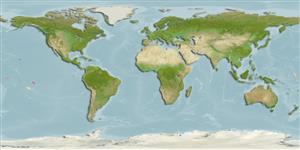>
Blenniiformes (Blennies) >
Blenniidae (Combtooth blennies) > Salariinae
Etymology: Entomacrodus: Greek, ento = inside + Greek, makros = big + Greek, odous = teeth (Ref. 45335); macrospilus: macrospilus meaning large spot, in reference its head spot (Ref. 40910).
Environment: milieu / climate zone / depth range / distribution range
Ökologie
seewasser; tiefenbereich 0 - 8 m (Ref. 54980). Tropical
Eastern Central Pacific: Marquesas Islands. Also Western Central Pacific (Ref. 12848).
Size / Gewicht / Alter
Maturity: Lm ? range ? - ? cm
Max length : 4.2 cm SL Männchen/unbestimmt; (Ref. 54980)
Rückenflossenstacheln (insgesamt) : 13; Rückenflossenweichstrahlen (insgesamt) : 15 - 16; Afterflossenstacheln: 2; Afterflossenweichstrahlen: 17 - 18. Absence of cirri on nape and supraorbital tentacle; upper lip margin completely crenulate; body coloration light brown; numerous tiny white spots and lateral series of paired (except for first and last) 7 dark reddish brown bars across body; males with black spot (almost same size as orbit) behind eye and uneven dark brown in females; males possibly with wide yellow area over branchiostegal membranes. Dorsal spines XIII, 15-16 (typically 16); anal rays typically 18, lateral line terminating below 10th and 11th dorsal spines; gill rakers 13-14 (Ref. 54980).
Facultative air-breathing in the genus (Ref. 126274); Adults are found along rocky shores exposed to strong surge (Ref. 54980). Feeds on filamentous algae (Ref. 89972). Oviparous. Eggs are demersal and adhesive (Ref. 205), and are attached to the substrate via a filamentous, adhesive pad or pedestal (Ref. 94114). Larvae are planktonic, often found in shallow, coastal waters (Ref. 94114).
Life cycle and mating behavior
Geschlechtsreife | Fortpflanzung | Ablaichen | Eier | Fecundity | Larven
Oviparous, distinct pairing (Ref. 205).
Springer, V.G., 1967. Revision of the circumtropical shorefish genus Entomacrodus (Blennidae: Salariinae). Proc. U.S. Natl. Mus. 122(3582):150 p. (Ref. 40910)
IUCN Rote Liste Status (Ref. 130435: Version 2024-2)
Bedrohung für Menschen
Harmless
Nutzung durch Menschen
Tools
Zusatzinformationen
Download XML
Internet Quellen
Estimates based on models
Preferred temperature (Ref.
123201): 27.6 - 29.3, mean 28.2 °C (based on 117 cells).
Phylogenetic diversity index (Ref.
82804): PD
50 = 0.5000 [Uniqueness, from 0.5 = low to 2.0 = high].
Bayesian length-weight: a=0.00776 (0.00356 - 0.01695), b=3.00 (2.81 - 3.19), in cm total length, based on LWR estimates for this (Sub)family-body shape (Ref.
93245).
Trophic level (Ref.
69278): 2.0 ±0.00 se; based on food items.
Widerstandsfähigkeit (Ref.
120179): hoch, Verdopplung der Population dauert weniger als 15 Monate. (Preliminary K or Fecundity.).
Fishing Vulnerability (Ref.
59153): Low vulnerability (10 of 100).
